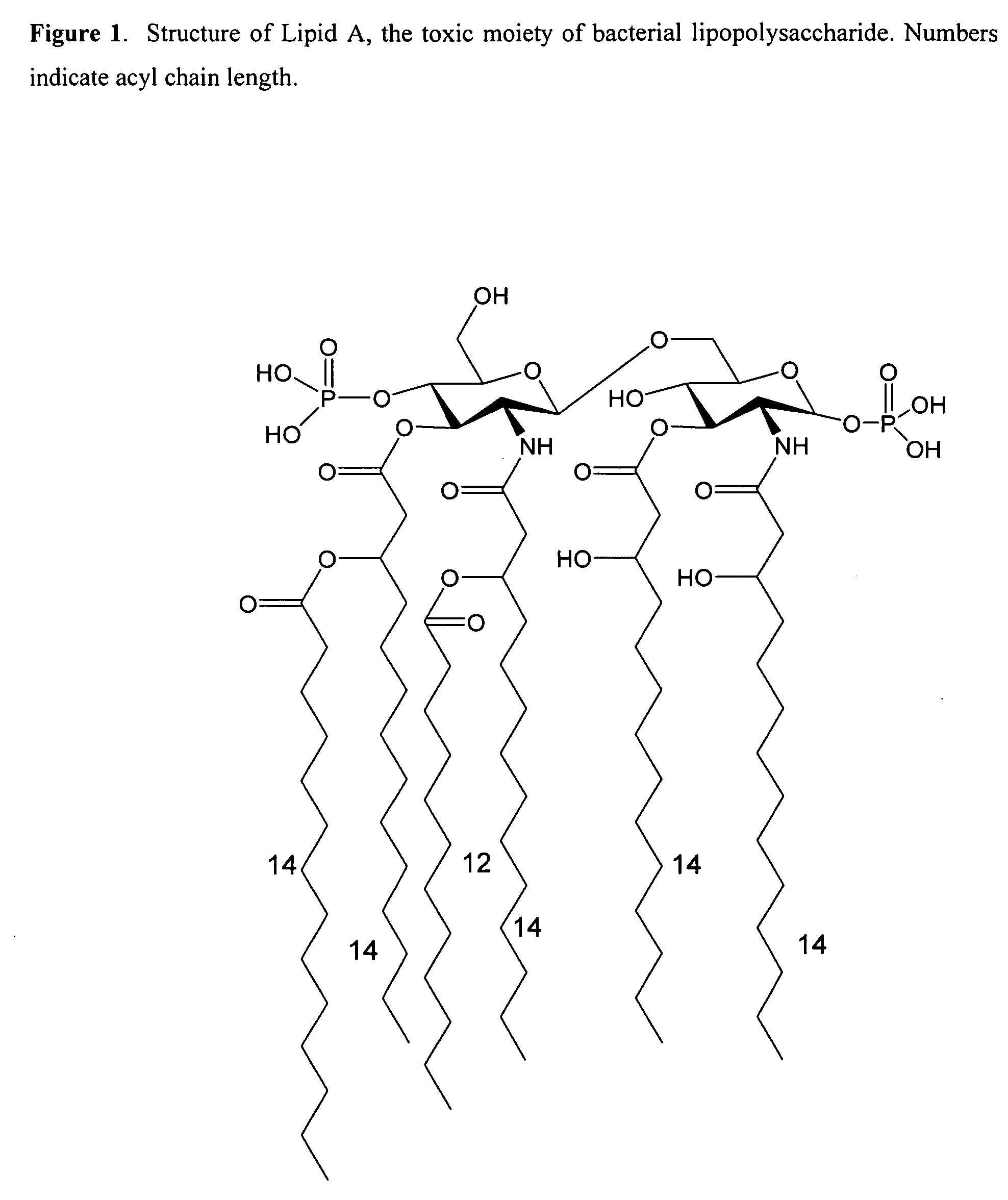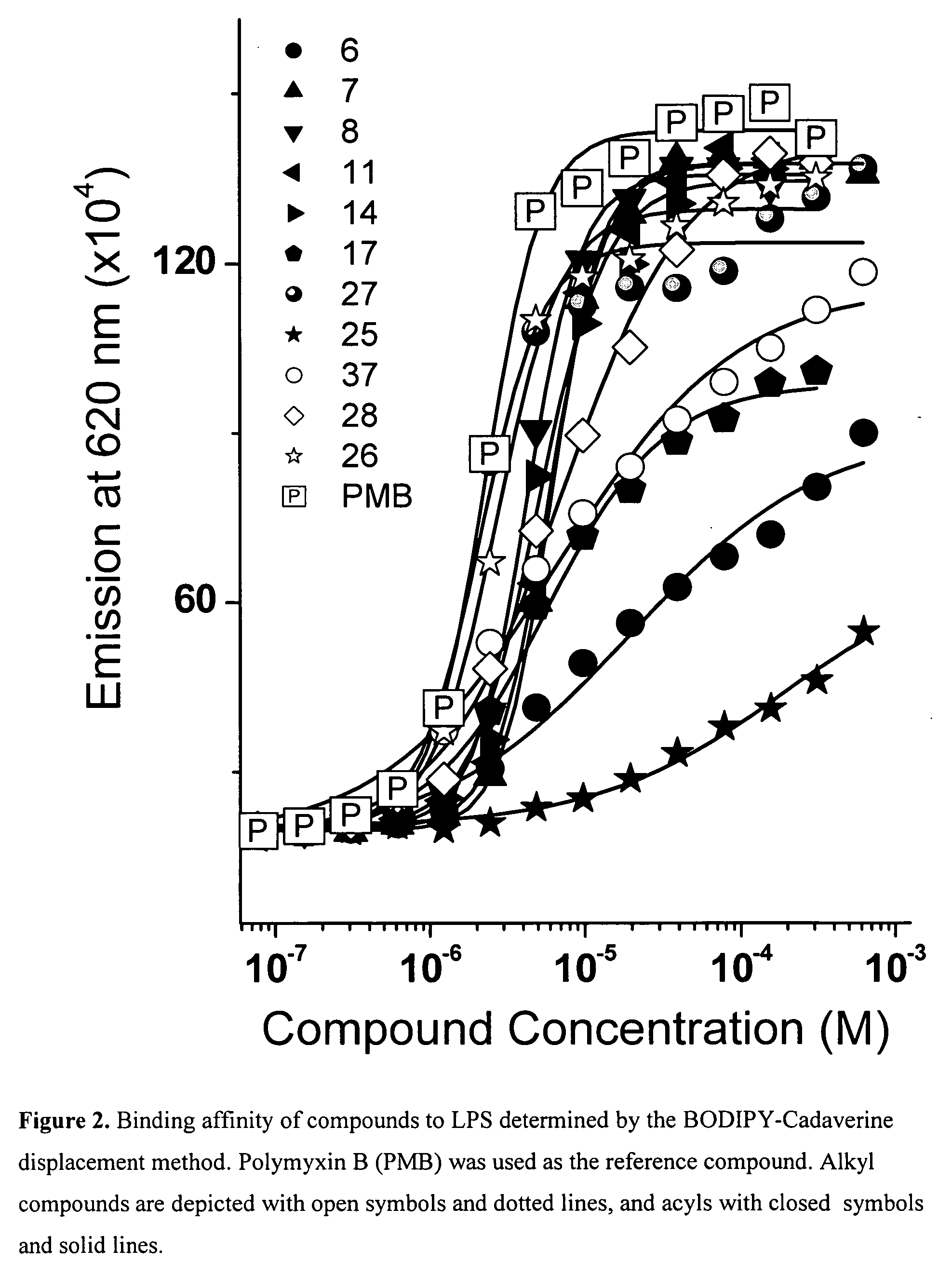Hydrophobic polyamine amides as potent lipopolysaccharide sequestrants
a polyamine amide and hydrophobic technology, applied in the direction of antibacterial agents, drug compositions, extracellular fluid disorders, etc., can solve the problems of inability to find specific modalities aimed at limiting the underlying pathophysiology, and achieve extended protection time-window, greater anticipated hydrolytic stability, and long protection duration
- Summary
- Abstract
- Description
- Claims
- Application Information
AI Technical Summary
Benefits of technology
Problems solved by technology
Method used
Image
Examples
example 2
Synthetic Methods for Precursor Compounds
[0054] Boc-L-Lys(Cbz)-N1-spermine-Boc3, (3)—To a stirred solution of spermine 1 (11.30 g, 1.4 eq, free base form) in MeOH (200 mL) is added dropwise over 1.5 h the active ester 2 (20.0 g, 40 mmole) in MeOH (200 mL) at room temp. After this dropwise addition, TLC analysis (b) shows that the expected mixture of products is formed (di-substituted side-product Rf=0.76; mono-substituted desired product Rf=0.50 and un-substituted spermine Rf=0.08). If the optimal ratio is not produced additional active ester in MeOH is added dropwise. After stirring for 2 h, the solvent is evaporated to give a yellow solid that is suspended in THF (300 mL) and H2O (100 mL). A solution of di-tert-butyl carbonate (43.5 g, 5.0 eq) in tetrahydrofuran (50 mL) is added at room temperature. The pH is adjusted periodically to ˜10 with a 10% Na2CO3 solution. A precipitate is noted after 10 minutes. After stirring for 18 h, TLC analysis (a) shows that the expected products ...
example 3
Boc-L-Lys-N1-spermine-Boc3
[0055] (4)—To a stirred solution of the orthogonally protected lysine-spermine conjugate 3 (19.4 g, 22.5 mmole) in EtOH (200 mL, ketone and aldehyde free EtOH) is added palladium 10 wt. % on activated carbon (10.0 g) in a round-bottom flask. The reaction flask is purged 3× with H2 is then placed under 5 psi H2 pressure. After stirring for 4.0 h at room temperature, TLC analysis (c) shows the reaction is complete. An extra amount of activated charcoal is added to the mixture and the catalyst is removed by filtering over a pad of Celite. The pad is washed with EtOH (2×50 mL) and the combined filtrates are evaporated to give 4 as a white foam in quantitative yield. Following evaluation by the above TLC system this product are used directly in the next examples.
example 4
Representative Acylation Reaction
[0056] L-Lys(palmitoyl)-N1-spermine (14)—To the amine precursor 4 (9.66 g, 13.22 mmol) is added Et3N (5.5 mL, 3.0 equiv) and dry CH2Cl2 (100 mL) via a syringe under an atmosphere of argon. The resulting solution is chilled to 0° C. in an ice bath and palmitoyl chloride (6.0 mL, 1.5 equiv) is added via a syringe. After stirring under an argon atmosphere overnight TLC analysis (c) shows that the expected product is formed. The solution is diluted in CH2Cl2 (100 mL) and H2O (100 mL). The organic layer is removed and the aqueous layer is extracted twice more with CH2Cl2 (2×100 mL). The combined organic layer is extracted with ice cold 0.1N HCl (100 mL) then brine and dried over MgSO4, filtered and concentrated to give the crude oil. This is purified via silica gel chromatography (column dimensions 8×17 cm) using stepwise elution with hexanes / EtOAc 1:1 containing 0%, 2%, 3%, 4%, 5% and 6% MeOH (500 mL each) to give the Boc-protected product 13 as a clear...
PUM
| Property | Measurement | Unit |
|---|---|---|
| volume | aaaaa | aaaaa |
| time | aaaaa | aaaaa |
| wt. % | aaaaa | aaaaa |
Abstract
Description
Claims
Application Information
 Login to View More
Login to View More - R&D
- Intellectual Property
- Life Sciences
- Materials
- Tech Scout
- Unparalleled Data Quality
- Higher Quality Content
- 60% Fewer Hallucinations
Browse by: Latest US Patents, China's latest patents, Technical Efficacy Thesaurus, Application Domain, Technology Topic, Popular Technical Reports.
© 2025 PatSnap. All rights reserved.Legal|Privacy policy|Modern Slavery Act Transparency Statement|Sitemap|About US| Contact US: help@patsnap.com



